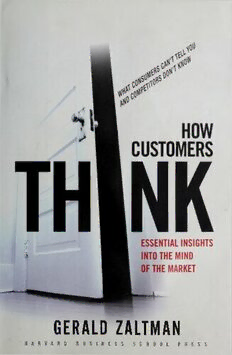
How Customers Think: Essential Insights into the Mind of the Market PDF
Preview How Customers Think: Essential Insights into the Mind of the Market
GERALD ZALTMAN H A R V A R D B U S I N E S S S C H O O L P R E S S $29.95 A NEW APPROACH TO UNDERSTANDING HOW-AND MWK—CUSTOMERS BUY Despite the resources spent on market research, nearly 80 percent of new offerings fail. The pattern is predictable: Customers say they want something, companies create it, and once it's available, customers don't buy it. Why? Is it because customers just don't know what they want? Gerald Zaltman sorts 4 through this puzzle and concludes that, at some level, customers do know, but marketing's most overused tools—surveys, f questionnaires, and focus groups—and conventional thinking don't dig deeply enough to help them discover and express it. In this mind-opening book, Zaltman argues that 95 percent of thinking happens in our unconscious. Therefore, unearthing your customers' desires requires you to understand the "mind of the market," that dynamic interplay between the consumers' and the marketers' thoughts that determines the outcome of every buying decision. Building on research from disciplines as diverse as neurology, sociology, literary analysis, and cognitive science, Zaltman offers rich insights into what happens within the complex system of mind, brain, body, and society as consumers contemplate'their needs and evaluate products. Continued on back flap HOW CUSTOMERS THINK Gerald Zaltman HOW CUSTOMERS THINK Essential Insights into the Mind of the Market Harvard Business School Press Boston, Massachusetts Copyright 2003 Gerald Zaltman All rights reserved Printed in the United States of America 07 06 05 04 03 54 No part of this publication may be reproduced, stored in or introduced into a retrieval system, or transmitted, in any form, or by any means (electronic, mechanical, photocopying, recording, or otherwise), without prior permission of the publisher. Requests for permission should be directed to [email protected], or mailed to Permissions, Harvard Business School Publishing, 60 Harvard Way, Boston, Massachusetts 02163. Library of Congress Cataloging-in-Publication Data Zaltman, Gerald. How customers think : essential insights into the mind of the market / Gerald Zaltman. p. cm. Includes bibliographical references and index. ISBN 1-57851-826-1 (alk. paper) 1. Consumer behavior—Psychological aspects. 2. Consumers—Psychology. 3. Marketing—Psychological aspects. 4. Creative thinking. I. Title. HF5415.32 .Z35 2003 658.8'342—dc21 2002011666 The paper used in this publication meets the requirements of the American National Standard for Permanence of Paper for Publications and Documents in Libraries and Archives Z39.48-1992. To all my doctoral students Contents Preface ix Part I Preparing for an Expedition One A Voyage from the Familiar 3 Two A Voyage to New Frontiers 27 Part il Understanding the Mind of the Market Three Illuminating the Mind 47 Consumers’ Cognitive Unconscious Four Interviewing the Mind/Brain 73 Metaphor Elicitation Appendix: The Metaphor-Elicitation Process 101 Five Interviewing the Mind/Brain 111 Response Latency and Neuroimaging Six Come to Think of It 129 Seven Reading the Mind of the Market 149 Using Consensus Maps Eight Memory’s Fragile Power 165 riii I Contents Nine Memory, Metaphor, and Stories 189 Ten Stories and Brands 211 Part III Thinking Differently and Deeply Eleven Crowbars for Creative Thinking 237 Twelve Quality Questions Beget Quality Answers 263 Thirteen Launching a New Mind-Set 285 Notes 291 Index 311 Acknowledgments 319 About the Author 323 Preface Neither art nor science stands still in representing our visible and invisible worlds. Marketing, as both art and science, can’t stand still either. Peter drucker, arguably the leading observer of manage ment today, suggests that businesspeople stand on the threshold of the “knowledge society.” In this society, a company’s com petitive advantage will come from an historically underdeveloped asset: the ability to capture and apply insights from diverse fields, not just from business. Drucker notes that many CEOs of large U.S. firms who were “appointed in the past ten years were fired as failures within a year or two,” partly for not cultivating this asset.1 Their failures ultimately resulted from woefully flawed paradigms for navigating an increasingly precarious environment—a situation not unlike that of the crew on the Titanic. Indeed, most marketing managers operate from a paradigm—a set of assumptions about how the world works—that prevents them from understanding and serving customers effectively. Elliot Ettenberg, chief executive officer of Customer Strategies Worldwide LLC in New York City, summarized the current state of affairs in a recent article published in The Economist. In Ettenberg’s words, “Everything else has been reinvented—distribution, new prod uct development, the supply chain. But marketing is stuck in the past.”2 The article argues that a far deeper and better understanding of con sumers is “a much harder task than describing the virtues of a product. While consumers have changed beyond recognition, marketing has ix
